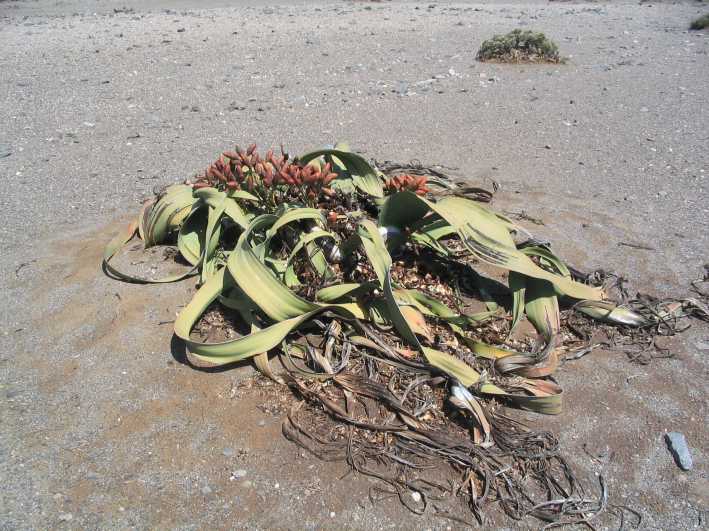- Spermatophyte
Taxobox
name = Seed Plants

image_width = 200px
image_caption = "Welwitschia mirabilis" a member of theGnetophyta
fossil_range =Devonian ? or earlier to recent
regnum =Plant ae
subdivision_ranks = Divisions
subdivision =
*Pinophyta
*Cycad ophyta
*Ginkgo phyta
*Gnetophyta
*Magnoliophyta
*Bennettitales †The spermatophytes (from the Greek word "Σπερματόφυτα") (also known as phanerogams) comprise thoseplant s that produceseed s. They are a subset of theembryophyte s or land plants. The living spermatophytes form five groups:*
cycad s, a subtropical and tropical group of plants with a large crown of compound leaves and a stout trunk,
*"Ginkgo ", a single living species oftree ,
*conifers , cone-bearing trees andshrub s,
*gnetophytes ,woody plant s in the genera "Gnetum ", "Welwitschia ", and "Ephedra", and
*angiosperms , the flowering plants, a large group including many familiar plants in a wide variety of habitats.In addition to the taxa listed above, the fossil record contains evidence of many
extinct taxa of seed plants. The so-called "seed ferns" (Pteridospermae ) were one of the earliest successful groups of land plants, and forests dominated by seed ferns were prevalent in the latePaleozoic . "Glossopteris " was the most prominenttree genus in the ancient southernsupercontinent ofGondwana during thePermian period. By theTriassic period, seed ferns had declined in ecological importance, and representatives of modern gymnosperm groups were abundant and dominant through the end of theCretaceous , when angiosperms radiated. Another Late Paleozoic group of probable spermatophytes were thegigantopterid s.Relationships and nomenclature
Seed-bearing plants were traditionally divided into
angiosperm s, or flowering plants, andgymnosperm s, which includes the gnetophytes, cycads, ginkgo, and conifers. Older morphological studies have shown a close relationship between the gnetophytes and the angiosperms,cite journal | url = http://www.amjbot.org/cgi/content/full/91/10/1437 | title = The plant tree of life: an overview and some points of view | author = Jeffrey D. Palmer, Douglas E. Soltis and Mark W. Chase | journal = American Journal of Botany | year = 2004 | volume = 91 | pages = 1437–1445 | doi = 10.3732/ajb.91.10.1437] in particular based onvessel elements . However, molecular studies (and some more recent morphological [cite journal | journal = The Journal of the Torrey Botanical Society | pages = 169–209 | title = Seed ferns and the origin of angiosperms | author = James A. Doyle | volume = 133 | issue = 1 | month = January | year = 2006 | id = doi | id = 10.3159/1095-5674(2006)133%5B169:SFATOO%5D2.0.CO;2 | label =10.3159/1095-5674(2006)133 [169:SFATOO] 2.0.CO;2 | year = 2006 | doi = 10.3159/1095-5674(2006)133 [169:SFATOO] 2.0.CO;2 ] and fossil [cite journal | url = http://aob.oxfordjournals.org/cgi/content/full/94/2/281 | title = A New Permian Gnetalean Cone as Fossil Evidence for Supporting Current Molecular Phylogeny | author = Zi-Qiang Wang | journal = Annals of Botany | year = 2004 | volume = 94 | issue = 2 | pages = 281–288 | doi = 10.1093/aob/mch138 | pmid = 15229124 ] papers) have generally shown aclade ofgymnosperm s, with the gnetophytes in or near the conifers. For example, one common proposed set of relationships is known as the "gne-pine hypothesis" and looks like: [Chaw, Shu-Miaw, Christopher L. Parkinson, Yuchang Cheng, Thomas M. Vincent, and Jeffrey D. Palmer. 2000. [http://www.pnas.org/cgi/content/full/97/8/4086 Seed plant phylogeny inferred from all three plant genomes: Monophyly of extant gymnosperms and origin of Gnetales from conifers] . "Proceedings of the National Academy of Sciences" 97: 4086-4091 ] [Bowe, L. Michelle, Gwénaële Coat, and Claude W. dePamphilis. 2000. [http://www.pnas.org/cgi/content/full/97/8/4092 Phylogeny of seed plants based on all three genomic compartments: Extant gymnosperms are monophyletic and Gnetales' closest relatives are conifers] . "Proceedings of the National Academy of Sciences " 97: 4092-4097.] [Soltis, Douglas E., Pamela S. Soltis and Michael J. Zanis. 2002. [http://intl.amjbot.org/cgi/content/full/89/10/1670 Phylogeny of seed plants based on evidence from eight genes] . "American Journal of Botany " 89: 1670-1681.]clade
1=angiosperm s
label2=gymnosperm s
2=clade
1=cycad s [cite journal | journal = Molecular Biology and Evolution | year = 2007 | volume = 24 | issue =6 | pages = 1366–1379 | doi = 10.1093/molbev/msm059 | title = Chloroplast Genome (cpDNA) of Cycas taitungensis and 56 cp Protein-Coding Genes of Gnetum parvifolium: Insights into cpDNA Evolution and Phylogeny of Extant Seed Plants | author = Chung-Shien Wu, Ya-Nan Wang, Shu-Mei Liu and Shu-Miaw Chaw | pmid = 17383970 ]
2="Ginkgo "
3=clade
1=clade
1=Pinaceae (the pine family)
2=gnetophytes
2=other conifersThe relationships between these groups should not be considered settled. [cite journal | title = Dating Dispersal and Radiation in the Gymnosperm Gnetum (Gnetales)—Clock Calibration When Outgroup Relationships Are Uncertain | author = Won, Hyosig; Renner, Susanne | journal = Systematic Biology | volume = 55 | issue = 4 | month = August | year = 2006 | pages = 610–622 | doi = 10.1080/10635150600812619 ]
A traditional classificationSpecify|date=February 2008 grouped put all the seed plants in a single division, with classes for our five groups:
*Division Spermatophyta
**Cycad opsida, the cycads
**Ginkgo opsida, the ginkgo
**Pinopsida , the conifers, ("Coniferopsida")
**Gnetopsida, the gnetophytes
**Magnoliopsida , theflowering plant s, or AngiospermopsidaA more modern classification ranks these groups as separate divisions (sometimes under the Superdivision Spermatophyta):
*Cycad ophyta, the cycads
*Ginkgo phyta, the ginkgo
*Pinophyta , theconifer s
*Gnetophyta, the gnetophytes
*Magnoliophyta, theflowering plant sReferences
Wikimedia Foundation. 2010.
